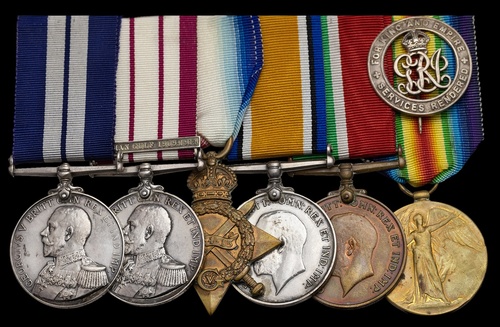
Auction: 25001 - Orders, Decorations and Medals
Lot: 313
The rare 'H.M.Y. Helga, Irish Sea 1918' D.S.M. group of six awarded to Leading Deck Hand E. E. Duff, Royal Navy and Merchant Fleet Auxiliary, who was in charge of Helga's gun when she was credited with sinking a German submarine
Despite her Irish heritage, Helga was commandeered by the Admiralty in March 1915 and later used by the Royal Navy to shell Liberty Hall in Dublin from the River Liffey with her pair of 12-pounder naval guns during the Easter Rising of 1916
Distinguished Service Medal, G.V.R. (Ldg. Dk. Hd. E. E. Duff, (A.P.) H.M.Y. Helga. Irish Sea 4. Apl 1918); Naval General Service 1915-62, 1 clasp, Persian Gulf 1909-1914 (210674. E.E. Duff, Lg. Sea. H.M.S. Highflyer.); 1914-15 Star (E.E. Duff, A.B. M.F.A.); British War and Victory Medals (E.E. Duff. D.H. M.F.A.); Mercantile Marine War Medal (Ernest. E. Duff), good very fine (6)
D.S.M. London Gazette 29 November 1918, the original citation states:
'HMY Helga attack on enemy Irish Sea 4 April 1918. In charge of gun when HMY Helga sank an enemy submarine.'
Ernest Edwin Duff was born at Deal, Kent on 12 April 1885. A telegraph boy, he enlisted in the Royal Navy as a Boy 2nd Class on 12 April 1903. A succession of shore and sea-based appointments followed and on 21 February 1911 he was drafted to Highflyer, serving aboard her until 29 May 1913. Later that same year he was invalided from the service with myopia on 9 October.
Duff married Kathleen Power in Dublin in September 1916 and despite his disability enrolled in the Merchant Fleet Auxiliary, joining H.M.Y. Helga for service during the Great War.
1916 Easter Uprising
Chris Shouldice takes up the story in his online article 'The Captain's Table':
'HMY Helga is infamously known for its role in shelling Dublin during the 1916 Rising but before she was pressed into war service, she had a far more benign profession as a protection cruiser and research vessel for the Department of Agriculture and Technical Instruction. Built in the Liffey Dockyard in Dublin in 1908 and originally named the Helga II, her purpose was to engage in fishery patrols, monitoring the coast for any illegal fishing activity. She was also equipped with a laboratory for marine research and took part in research projects like the survey of Clare Island in 1909.
As the British found themselves in an unexpectedly lengthening war in Europe, she was taken over by the Admiralty in 1915 for military purposes as an armed auxiliary patrol yacht. She was renamed the HMY Helga and served as an anti-submarine patrol vessel and an armed escort.
It was however in Ireland during the 1916 Rising that the Helga's most notable acts occurred. The Helga was summoned by British forces to the capital to use artillery to root out Irish Volunteers. On the 26th of April 1916, positioned on the Liffey, she raised her 12-pound artillery guns over the Loop Line railway bridge and fired at her first target Liberty Hall, the headquarters of the Citizen Army. Her shots were less than accurate, and her shells destroyed much of the surrounding buildings and beyond. She also targeted the GPO and Bolland Mills which Eamon De Valera had occupied.
1918 rescuing survivors from R.M.S. Leinster.
In 1918, she successful sank a German U-Boat Submarine off the coast of the Isle of Man. This was the Helga's first and sole confirmed sinking during the war. However, the presence of U-boats continued to be a real threat to the merchant and passenger vessels in the Irish Sea.
In 1917, the Germans began placing their U-boats in the Approaches, the name given to the region near the entrance and exit to the Irish Sea. This was an attempt to stifle the British attempts at Trans-Atlantic trade. The RMS Leinster was typical of their targets, a passenger ship which, along with three other sister ships, made daily crossings from Kingstown (now Dún Laoghaire) to Holyhead. Known for its exceptional speed, the RMS Leinster held a place of pride in Irish eyes, as it was seen to be their representative in the commercial competition over the Irish Sea. The Leinster along with its sister ships, had won the tender for the Royal Mail delivery from Ireland to the British mainland. While it provided valuable employment to the people of Kingstown and Holyhead in Wales, the requirements of this contract were strict. There was a stipulation that the post collected in Dublin had to be delivered to the mainland the following day. This meant that the RMS Leinster ran daily, and on-time no matter the circumstances.
On the morning of the 9th of October (1918), the RMS Leinster set out from Dun Laoghaire, filled to capacity, for what was to be its final voyage. Despite the U-boat warnings, that morning was no different, the war had been in action for four years, and the crossings were routinely unprotected. Furthermore, the level of censorship which the British government exercised over the press meant that many civilians were largely unaware of the danger that awaited them. Lurking under the waters off Kish Island was U-boat 123, which had already sunk two boats since it left Germany days earlier. At 09:45, the first torpedo was fired, shooting past the brow of the Leinster. The second was a direct hit, and a third torpedo sunk the entire vessel.
Coaling, or refuelling, that same morning in Dublin was HMY Helga, the same ship which had been shelling the city two and a half years earlier. That day however, the Helga succeeded in being first on the scene of the Leinster sinking, and managed reach it just in time to rescue approximately 90 passengers, though there is some confusion as to the exact number. These passengers were not returned to Kingstown but disembarked in Wales. Due the controls on wartime press, the British government were keen to keep any such disasters out of the public eye'.
Duff died on 11 November 1935 at Dover, at the time he was employed on the Trinity House Pilot Cutter, S.S. Prudence. (The Dover Express of 22 November 1935 refers).
Sold together with his silver wound badge, this numbered B158828, a copy photo of Helga, a postcard of Highflyer, copy of Helga's ships log from the National Maritime Museum for 4-5 April 1918 and a copy of Irish Naval service.
Subject to 20% VAT on Buyer’s Premium. For more information please view Terms and Conditions for Buyers.
Estimate
£800 to £1,000
Starting price
£600




